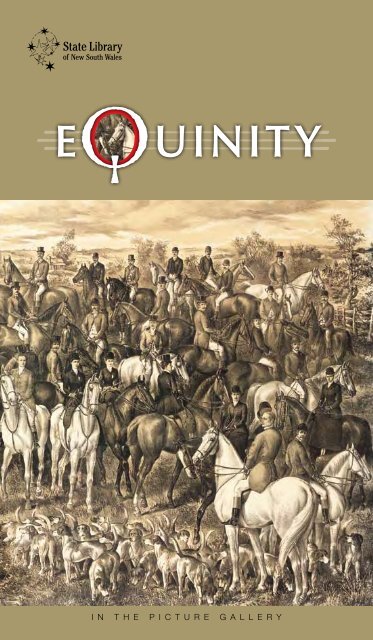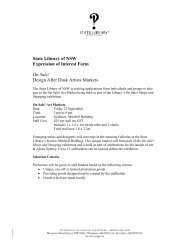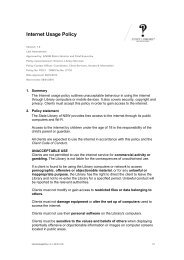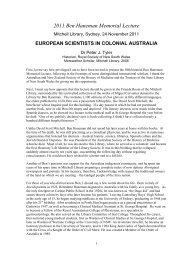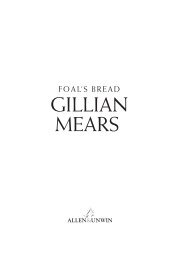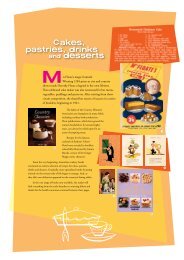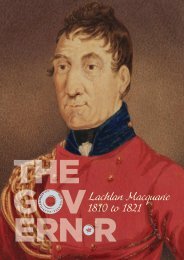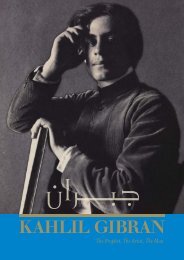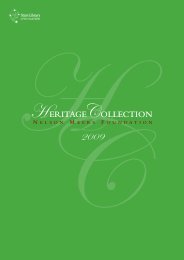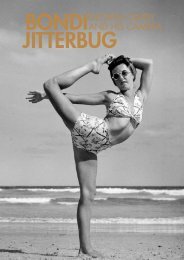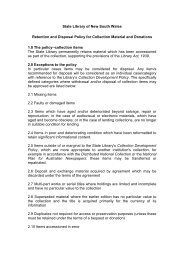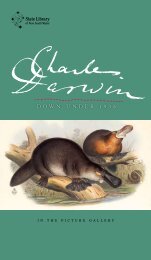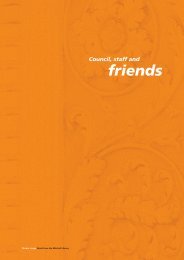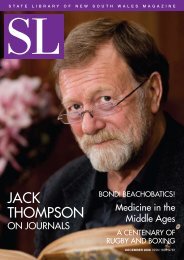Equinity - Exhibition gallery guide - State Library of New South Wales
Equinity - Exhibition gallery guide - State Library of New South Wales
Equinity - Exhibition gallery guide - State Library of New South Wales
Create successful ePaper yourself
Turn your PDF publications into a flip-book with our unique Google optimized e-Paper software.
in the Picture Gallery
in the Picture Gallery
The Picture Gallery presents highlights from the <strong>State</strong> <strong>Library</strong>’s collections.<br />
The <strong>State</strong> <strong>Library</strong> acknowledges the generous support <strong>of</strong> the Nelson Meers<br />
Foundation and the assistance <strong>of</strong> the volunteer <strong>guide</strong>s in the Picture Gallery.<br />
A free exhibition from 8 October 2007 to 13 January 2008<br />
<strong>Exhibition</strong> opening hours: 9 am to 8 pm Monday to Thursday, 9 am to 5 pm Friday,<br />
11 am to 5 pm weekends<br />
<strong>State</strong> <strong>Library</strong> <strong>of</strong> <strong>New</strong> <strong>South</strong> <strong>Wales</strong><br />
Macquarie Street Sydney NSW 2000<br />
Telephone (02) 9273 1414 Facsimile (02) 9273 1255<br />
TTY (02) 9273 1541<br />
Email library@sl.nsw.gov.au www.sl.nsw.gov.au<br />
Curator and Project manager: Lisa Loader<br />
<strong>Exhibition</strong> designer: Elin Thomas<br />
Editor: Helen Cumming<br />
Graphic designer: Dominic Hon<br />
Preservation project leader: Tegan Anthes<br />
All photographic and imaging work is by Andrew LaMoreaux,<br />
Phong Huu Nguyen and Scott Wajon, Imaging Services<br />
Printer: Macdonald & Masterson Printing Pty Ltd<br />
Paper: 300 gsm Euro Silk (cover), 130 gsm Euro Silk (text)<br />
Print run: 5000<br />
P&D 2469-10/2007<br />
ISSN 1448–2622<br />
ISBN 0 7313 7178 X<br />
© <strong>State</strong> <strong>Library</strong> <strong>of</strong> <strong>New</strong> <strong>South</strong> <strong>Wales</strong>, October 2007<br />
Acknowledgments<br />
The interpretive text for this exhibition draws on the research <strong>of</strong> a number <strong>of</strong> scholars.<br />
The curator would like to acknowledge in particular the work <strong>of</strong>: Alexander Yarwood, Keith R Binney,<br />
Nanette Mantle, Heather B Ronald, Glen McLaren, Colin Laverty, H McGregor and Sam Everingham.<br />
Fine art prints <strong>of</strong> artworks from this exhibition can be<br />
ordered from the <strong>Library</strong> Shop, telephone (02) 9273 1611 or<br />
email .<br />
Cover: A meet <strong>of</strong> the Melbourne Hunt Club (detail), 1893, Herbert James Woodhouse, ML 463<br />
Inside cover: Plan and Elevation <strong>of</strong> the Governor’s Stable and Offices at Sydney,<br />
<strong>New</strong> <strong>South</strong> <strong>Wales</strong>, 1820, 1820, Francis Greenway, V1/Pub/Gov S/1
Foreword<br />
<strong>Equinity</strong> brings to light a selection <strong>of</strong> some<br />
40 fine examples <strong>of</strong> equestrian art drawn<br />
from the <strong>State</strong> <strong>Library</strong>’s collections, with<br />
many displayed in our galleries for the first<br />
time. This exhibition focuses on the engagement<br />
<strong>of</strong> colonial artists with the horse as a subject and<br />
considers how their works relate to the significance <strong>of</strong><br />
the horse in nineteenth century Australia.<br />
On display are oil paintings, pencil drawings, watercolours,<br />
aquatints and lithographs by both pr<strong>of</strong>essional and amateur artists<br />
from the colonial period. This selection <strong>of</strong> paintings not only reveals<br />
the impressive achievements <strong>of</strong> artists categorised as ‘sporting<br />
artist’ or ‘animal painter’ (and who therefore are little known),<br />
but also highlights the horse in works by artists well known for<br />
their contributions to other artistic genres.<br />
Selected by curator Lisa Loader, these works provide us with a wideranging<br />
view <strong>of</strong> the colonial horse. They demonstrate the ubiquitous<br />
presence <strong>of</strong> the horse and highlight its value to the European settlers<br />
who came to these shores from the late eighteenth century.<br />
Regina A Sutton<br />
NSW <strong>State</strong> Librarian & Chief Executive
<strong>Equinity</strong><br />
The first documented members <strong>of</strong> genus Equus to set foot<br />
on the continent were nine horses obtained from the Cape<br />
<strong>of</strong> Good Hope and transported to Port Jackson with the<br />
First Fleet in January 1788. Seven were government owned (one<br />
stallion, three mares and three foals), with two horses owned by<br />
marine <strong>of</strong>ficers. 1<br />
The horse population <strong>of</strong> the colony increased — slowly at first<br />
— through quality imports and local breeding to number 4532<br />
by 1822, significantly less than the number <strong>of</strong> people <strong>of</strong> European<br />
origin at the time (approximately 26 500). 2 The early horse<br />
imports were driven by the enormous passion for horse sports, the<br />
suitability and pr<strong>of</strong>itability <strong>of</strong> breeding, and the need for reliable<br />
horses to assist with developing the colony. Horses had become<br />
so plentiful by 1870 that the Hon. John Creed observed: ‘almost<br />
everyone in the country had a saddle-horse’. 3<br />
page 2
Above: Promenade<br />
Coogee Beach,<br />
c. 1870–1895,<br />
Harold Brees, V/2<br />
Pictorial records featuring the horse can be found<br />
from as early as 1804 in a depiction <strong>of</strong> the Castle Hill<br />
uprising. 4 Horses featured in almost every aspect <strong>of</strong> nineteenth<br />
century life and appear within narrative artworks depicting scenes<br />
<strong>of</strong> exploration, trade, and bush and city life. The demand by owners<br />
to have prized horses documented, and to acquire works depicting<br />
horse sports, saw pr<strong>of</strong>essional artists produce a significant number<br />
<strong>of</strong> such works.<br />
Although the content <strong>of</strong> these works is Australian, the form is<br />
predominantly British, adhering to the pictorial conventions for<br />
sporting and animal art widely promulgated through engravings<br />
and prints that were readily available in the colony. The majority <strong>of</strong><br />
pr<strong>of</strong>essional artists working in the colony during this period were<br />
born and trained in Europe.<br />
Lisa Loader<br />
Curator<br />
page 3
Portraiture<br />
During the early nineteenth century, Arab horses and<br />
thoroughbreds were brought to the colony in significant<br />
numbers for breeding and sports such as racing,<br />
steeplechasing and hunting. There was a sharp increase in<br />
thoroughbred arrivals from the 1830s when these pursuits were<br />
well established. 5<br />
This increase in blood or pedigree horse ownership generated<br />
a significant market for pr<strong>of</strong>essionally painted equine portraits<br />
by specialists such as Edward Winstanley, Joseph Fowles and<br />
Frederick Woodhouse Senior — all arrived in the colony between<br />
1833 and 1858.<br />
page 4
The demand for such works, by owners keen to celebrate their<br />
equine possessions and document important sporting achievements,<br />
is evident in the way artists advertised their services in the press. For<br />
example, Joseph Fowles stated in 1858 that he would ‘paint pictures<br />
<strong>of</strong> Australian “cracks” and will dispose <strong>of</strong> engravings <strong>of</strong> horses from<br />
his own pictures’. 6<br />
In early nineteenth century Britain there was a strong demand for<br />
equine portraits, as indicated by artist Ben Marshall on his reason<br />
for going to <strong>New</strong>market:<br />
I have good reason for going. I discover many a man who will pay<br />
me fifty guineas for painting his horse, who thinks ten guineas too<br />
much for painting his wife. 7<br />
The British approach to equine portraiture provided<br />
the model for colonial artists, with George Stubbs<br />
particularly influential in the development <strong>of</strong> this<br />
genre. Stubbs extensively documented the emerging<br />
English breed, the thoroughbred, during the second<br />
half <strong>of</strong> the eighteenth century.<br />
Colonial equine portraits, such as Flying Buck, based<br />
on a work by Frederick Woodhouse Senior, comfortably<br />
fit within the genre’s parameters. The pose varied<br />
little: the horse was usually presented in a full-length<br />
side-view with head in pr<strong>of</strong>ile, sometimes including<br />
informative props or background; racehorses were <strong>of</strong>ten<br />
depicted at a racecourse, with jockey up and grooms or<br />
owner present.<br />
Above left: Nazeer Farrib: <br />
A high caste Arab, the<br />
property <strong>of</strong> Jas. Raymond <br />
Esqr. <strong>of</strong> Varroville, 1846, <br />
Edward Winstanley, <br />
ML 282<br />
Above right: Race horse<br />
and jockey, c. 1850,<br />
Joseph Fowles , ML 427<br />
—<br />
Opposite page: Flying<br />
Buck: The winner <strong>of</strong> the<br />
first Australian Champion<br />
Sweepstakes, October 1st<br />
1859, c. 1859, De Gruchy<br />
& Leigh after Frederick<br />
Woodhouse Senior,<br />
DG XV*/Gen/7<br />
page 5
Portrait commissions <strong>of</strong> champion<br />
racehorses, prized steeplechasers,<br />
hunters and blood horses were obtained<br />
from the petit bourgeois, the wealthy,<br />
and high-ranking government <strong>of</strong>ficials.<br />
These works <strong>of</strong> portraiture — along<br />
with lithographic prints that could be<br />
mass-produced and sold to the general<br />
public — provided a reliable source <strong>of</strong><br />
income for a number <strong>of</strong> artists.<br />
The horse was also depicted in the portraits <strong>of</strong> colonial residents<br />
to enhance the owner’s status, as in Commissioner Henry Bingham<br />
(artist unknown). Publican Stephen Butts chose this approach<br />
(Stephen Butts on a white horse, Macquarie Street, Sydney,<br />
by Joseph Fowles). Butts’ portrayal references those <strong>of</strong> political<br />
leaders and royalty who are similarly shown on horseback in oil<br />
paintings from the sixteenth century onwards. This painting also<br />
demonstrates Butts’ great pride in his possessions.<br />
The white horse appears regularly in colonial equestrian works, and<br />
this is likely for two main reasons: the availability <strong>of</strong> Arab horses<br />
and for their symbolic qualities <strong>of</strong> purity, valour and bravery.<br />
page 6
The emergence <strong>of</strong> photography in the late nineteenth<br />
century ultimately led to a decline in commissions<br />
and the end <strong>of</strong> an era in equine portraiture. Frederick<br />
Woodhouse Senior commented on this situation:<br />
A Melbourne Cup always meant £100 to me and the<br />
work occupied about a fortnight, but photography<br />
knocked me out. Now an owner can get a picture<br />
<strong>of</strong> his horse in a sixpenny weekly, or for nothing<br />
— wrapped round the meat. 8<br />
Photography was to have a significant impact on the<br />
related field <strong>of</strong> sporting art, as it changed the manner<br />
in which artists depicted the gait <strong>of</strong> the horse in<br />
motion.<br />
Opposite page: Beagle, an<br />
Australian bred horse by<br />
Skeleton, the property <strong>of</strong><br />
Capt. PP King, RN, 1839,<br />
James Lethbridge Templer,<br />
SV*/Hors/5<br />
Commissioner Henry<br />
Bingham, c. 1840s?,<br />
artist unknown, ML 632<br />
—<br />
Below: Stephen Butts on<br />
a white horse, Macquarie<br />
Street, Sydney, c. 1850<br />
Joseph Fowles, DG 250<br />
page 7
Sporting pursuits<br />
Horse sports were popular from the early days <strong>of</strong> settlement<br />
and typically centred on racing, steeplechasing and<br />
hunting. Most equine portrait artists produced images<br />
<strong>of</strong> sporting pursuits as original works and prints. For a number <strong>of</strong><br />
artists sporting art was a particular focus.<br />
Race meetings were held at Parramatta and in the Hawkesbury<br />
River district soon after settlement. The first <strong>of</strong>ficial race meeting<br />
in NSW was held over three days in October 1810 on the Old Race<br />
Course (now known as Hyde Park). This meeting, organised by<br />
<strong>of</strong>ficers <strong>of</strong> the 73rd Regiment, confirmed that the sport <strong>of</strong> English<br />
racing had been ‘successfully transplanted in the colony’. 9<br />
The earliest recorded steeplechase event in the colony was staged<br />
over five miles (8 km) between the Sydney suburbs <strong>of</strong> Botany and<br />
Coogee in 1832. 10 The popularity <strong>of</strong> this sport saw a series <strong>of</strong> three<br />
annual steeplechase events being held during the mid 1840s, the<br />
Hawkesbury Stakes. This race was held over a three-mile (4.8 km)<br />
course at Mr Charles Abercrombie’s estate, located at present-day<br />
Birkenhead Point. Scenes from the first race <strong>of</strong> this series are shown<br />
in Five-Dock grand steeple-chase, 1844.<br />
Mounted hunts were organised from the early 1800s and quarry<br />
included the kangaroo, emu, wallaby and dingo. Formal hunt<br />
clubs, soon established in districts where sportsmen settled, retained<br />
many <strong>of</strong> the British hunt’s customs, along with its status as an<br />
upper-class pastime. 11<br />
A meet <strong>of</strong> the Melbourne Hunt Club by Herbert Woodhouse<br />
shows members closely adhering to the formal dress <strong>of</strong> the English<br />
page 8
hunt. The quarry <strong>of</strong> these hunts continued to be native animals<br />
until imported species, such as the red deer, fox and hare, became<br />
available in the 1870s.<br />
Artworks depicting horse sports, popular in Britain from the<br />
early eighteenth century, led to artists developing conventions in<br />
the choice <strong>of</strong> phase or stage shown. This approach is evident in<br />
representations <strong>of</strong> colonial sports. The scenes depicted in Five-Dock<br />
grand steeple-chase reflect stages usually included in British works<br />
<strong>of</strong> similar race events, including the start or first leap, floundering<br />
in the brook, clearing a fence or wall, and the finish. The prints <strong>of</strong><br />
British artist Henry Thomas Alken were influential in depicting<br />
steeplechasing, effectively providing a template for colonial artists.<br />
In typically British style, A meet <strong>of</strong> the Melbourne Hunt Club<br />
focuses on the most formal phase in the standard hunting narrative:<br />
the meet. This phase is less frequently represented in colonial works<br />
as most artists chose to depict the thrill <strong>of</strong> the chase. These works<br />
<strong>of</strong>ten show the hunter in a downhill gallop negotiating an array<br />
<strong>of</strong> natural obstacles in pursuit <strong>of</strong> native quarry, with a landscape<br />
<strong>of</strong> eucalypts and grasstrees. Samuel Thomas Gill’s depictions <strong>of</strong><br />
the hunt — and the availability <strong>of</strong> his lithographs<br />
such as The chase — were particularly influential<br />
in the representation <strong>of</strong> colonial hunting scenes by<br />
other artists. 12<br />
Sporting artists also developed a style <strong>of</strong> treatment for<br />
a group <strong>of</strong> horses galloping called the ‘rocking horse’<br />
or ‘hobbyhorse’ gait, with front and back legs fully<br />
extended. W Scott’s depiction <strong>of</strong> A race meeting at<br />
Petersham is a good example <strong>of</strong> this treatment. This<br />
work also shows the common practice <strong>of</strong> flattening and<br />
elongating the horse to suggest speed, while stretching<br />
the head and neck to emphasise effort. 13<br />
Opposite page: The brook,<br />
Five-Dock grand steeplechase,<br />
1844, Thomas<br />
Balcombe after Edward<br />
Winstanley, PXD 659<br />
The stone wall, Five-<br />
Dock grand steeple-chase,<br />
1844, Thomas Balcombe<br />
after Edward Winstanley,<br />
PXD 659<br />
—<br />
Below: A race meeting at<br />
Petersham (detail), c. 1845,<br />
W Scott, V1/Race/1<br />
page 9
The work <strong>of</strong> British photographer Edwarde Muybridge during the<br />
1870s had a dramatic effect on the use <strong>of</strong> this pictorial convention.<br />
For the first time, a sequence <strong>of</strong> photographs captured by a series <strong>of</strong><br />
cameras demonstrated how a horse galloped. The resulting images<br />
showed that a horse’s feet were indeed all <strong>of</strong>f the ground at one<br />
page 10
moment, but it was when they were bunched together<br />
under the body. Muybridge’s photographs revealed the<br />
fallacy <strong>of</strong> the ‘rocking horse’ gait, which was phased out<br />
after his photographs were published.<br />
Above: Kangaroo hunting,<br />
n.d., in ‘HO Lamb,<br />
The Floral Album’,<br />
1862, Thomas Balcombe<br />
(attributed), PXA 7123 f.77<br />
page 11
More work than play<br />
Below left: Mortimer<br />
William Lewis out driving,<br />
c. 1838–40, Edward<br />
Winstanley (attributed),<br />
SV*/CARR/1<br />
Below right: View <strong>of</strong> a man<br />
on horseback (detail), 1892,<br />
Percy Frederick Seaton<br />
Spence, DG SV*/GEN/33<br />
The horse in colonial Australia was<br />
employed as a draught animal<br />
for agriculture and industry, and<br />
as a saddle, pack and carriage animal<br />
for leisure, transportation, exploration<br />
and livestock management. Artworks<br />
by both pr<strong>of</strong>essional and amateur artists<br />
extensively document the horse in these<br />
roles. The mounted bushranger and<br />
stockman were particularly popular, along<br />
with scenes <strong>of</strong> the working carriage horse.<br />
Artists depicted the variety <strong>of</strong> horse-drawn passenger vehicles<br />
from Cobb & Co coaches traversing the countryside, to private<br />
gigs going about the town. Many <strong>of</strong> these images reference the<br />
compositions <strong>of</strong> British artists whose works were widely available<br />
as prints and engravings. For example, FG Lewis and Edward<br />
Winstanley’s <strong>New</strong> Post Office, George Street, Sydney is derived<br />
from James Pollard’s coaching prints.<br />
The driving <strong>of</strong> horse-drawn vehicles was considered a sport when<br />
undertaken by a gentleman and was regularly included in the<br />
repertoire <strong>of</strong> colonial artists. Works focusing on other aspects<br />
<strong>of</strong> colonial life, particularly stock work and bushranging, also<br />
reference conventions <strong>of</strong> sporting art in their depiction <strong>of</strong> the horse<br />
in motion.<br />
page 12
Settlement <strong>of</strong> outlying regions accelerated during the<br />
1830s and the stockman was increasingly in demand. It<br />
is from this period that illustrations <strong>of</strong> stock work begin<br />
to appear, mostly produced by amateur artists directly<br />
involved in station activities. 14 The drawings in John<br />
Stirling’s ‘Sketches in the Station Wyong N.S.W 1884’<br />
are typical examples. Pr<strong>of</strong>essional artists including<br />
Samuel Thomas Gill and William Strutt depicted this<br />
facet <strong>of</strong> colonial life from the 1850s.<br />
Above: Outward<br />
bound, c. 1862–1863,<br />
Samuel Thomas Gill,<br />
PXA 1983 f.19<br />
Below: Bushranger<br />
and police, Sep 17,<br />
1875 (detail), 1875<br />
George Hamilton,<br />
DG SV*/GEN/17<br />
The stockman is <strong>of</strong>ten shown rounding up cattle, galloping down<br />
a hillside or over rough country, riding out to or returning from<br />
stock work, or undertaking duties in cattle yards. In works such<br />
as William Strutt’s Black Thursday 1850: The track <strong>of</strong> death, the<br />
mounted stockman is depicted battling the harsh conditions <strong>of</strong> the<br />
Australian bush. Artworks <strong>of</strong><br />
the late nineteenth century<br />
begin to show the stockman in<br />
an heroic manner, as in Percy<br />
Spence’s View <strong>of</strong> a man on<br />
horseback.<br />
It was predominantly<br />
stockmen, with their superior<br />
horsemanship and bush<br />
knowledge, who became<br />
bushrangers.<br />
page 13
Right: Party landed<br />
from HMS Rattlesnake,<br />
1849, Thomas Huxley,<br />
DG SV*/EXPLO/1<br />
—<br />
Opposite page: The Start<br />
<strong>of</strong> the Burke and Wills<br />
exploring expedition from<br />
Royal Park, Melbourne,<br />
August 20, 1860, 1861,<br />
William Strutt, ML 373<br />
Landing horses from<br />
Australia (detail), c. 1834, <br />
Artist unknown, <br />
DG SV*/Hors/1(a)<br />
Their horsemanship was central to the bushranging myth 15<br />
with bushrangers <strong>of</strong>ten depicted in flight at great speed on their<br />
impressive (and <strong>of</strong>ten stolen) mounts.<br />
Instances <strong>of</strong> bushranging escalated from the mid-nineteenth<br />
century. This was due to the discovery <strong>of</strong> gold in the 1850s and<br />
later, in the 1860s and 70s, to poor squatters’ sons being drawn<br />
to the more exciting and pr<strong>of</strong>itable life <strong>of</strong> bushranging. Passenger<br />
coaches such as Cobb & Co were frequently robbed.<br />
Horsemanship was the key to successful land exploration for much<br />
<strong>of</strong> the nineteenth century. Horses were employed in this field<br />
from as early as 1802, when George Caley explored the region<br />
west <strong>of</strong> Sydney, although exploration parties were not usually fully<br />
mounted until the late 1840s. 16 Horses participating in expeditions<br />
ranged from Timor ponies to the colonial saddle horse the Waler,<br />
named after its place <strong>of</strong> origin, <strong>New</strong> <strong>South</strong> <strong>Wales</strong>. By the 1870s<br />
camels were replacing horses to explore the arid inland.<br />
Amateur on-the-spot works, such as Party landed from<br />
H.M.S Rattlesnake by Thomas Huxley, typically depict the horse<br />
as part <strong>of</strong> a significant milestone or novel event. Pr<strong>of</strong>essional artists<br />
page 14
were more likely to feature the horse within a standard narrative<br />
sequence that may include the departure, early stages <strong>of</strong> the journey,<br />
expedition threatened by adverse conditions, and the return. 17<br />
Walers, predominantly a mixture <strong>of</strong> Arab and thoroughbred, were<br />
used in the colony and exported for use as remounts by the British<br />
Army. The first shipment <strong>of</strong> 32 left the colony for India in June<br />
1834. These horses were in demand until the 1930s. Artworks such<br />
as Landing horses from Australia highlight some <strong>of</strong> the difficulties<br />
associated with this trade. Subsequently, ‘Waler’ became the term<br />
commonly used for an Australian horse abroad. 18<br />
page 15
Above: The chase (detail),<br />
c. 1856, Samuel Thomas<br />
Gill, PX*D 384 f.24<br />
These artworks reveal the spirit <strong>of</strong> colonial life and the significant<br />
role <strong>of</strong> the horse.<br />
Horses were the focus <strong>of</strong> leisure and sporting pursuits, provided<br />
unparalleled assistance as working animals and attracted revenue to<br />
the colony through the export trade in Walers. For these reasons the<br />
horse was a valuable commodity throughout the nineteenth century<br />
and held in high esteem.<br />
The settlers’ desire to recreate aspects <strong>of</strong> the English lifestyle is also<br />
reflected in these works, highlighting the adaptations required to<br />
accommodate the unique environment <strong>of</strong> colonial Australia.<br />
The influence <strong>of</strong> British cultural forms on depicting colonial life is<br />
evident, due in part to the ready availability <strong>of</strong> sporting prints and<br />
engravings by British artists, along with the fact that most pr<strong>of</strong>essional<br />
artists working in the colony were born and trained in Europe.<br />
Footnotes<br />
1. Keith R Binney, Horsemen <strong>of</strong> 5. Jack Pollard, The pictorial 9. Pollard, op.cit., p. 14<br />
the first frontier (1788–1900) history <strong>of</strong> Australian horse racing, 10. Ibid, p. 48<br />
and the serpent’s legacy, Volcanic Sydney, Lansdowne Press, 1981,<br />
11. Mantle, op.cit., p. 99<br />
Productions, Neutral Bay, 2005, p. 22<br />
12. Ibid, p. 106<br />
p. xvi 6. Joan Kerr (ed.), Dictionary <strong>of</strong><br />
13. Laverty, op.cit., p. 38<br />
2. Carol J. Baxter (ed.), General Australian artists, Sydney, Power<br />
muster and land and stock<br />
Institute <strong>of</strong> Fine Arts, University <strong>of</strong> 14. Mantle, op.cit., p. 65<br />
muster <strong>of</strong> <strong>New</strong> <strong>South</strong> <strong>Wales</strong> Sydney, 1984, p. 271 15. Ibid, p. 148<br />
1822, Sydney, ABGR in association 7. Judy Egerton, British sporting 16. Glen McLaren, Beyond<br />
with the Society <strong>of</strong> Australian and animal paintings, 1655–1867: Leichhardt: Bushcraft and the<br />
Genealogists, 1988. A catalogue, London, Tate Gallery exploration <strong>of</strong> Australia, <strong>South</strong><br />
3. Nanette Mantle, Horse and rider for the Yale Center for British Art, Fremantle, Fremantle Arts Centre<br />
in Australian legend, Carlton, 1978, p. 191 Press, 1996, p. 31<br />
Miegunyah Press, 2004, p. 41 8. Colin Laverty, Australian colonial 17. Mantle, op.cit., p. 162<br />
4. Ibid, p. 5 sporting painters: Frederick 18. AT Yarwood, Walers: Australian<br />
Woodhouse and sons, Sydney, horses abroad, Carlton, University<br />
David Ell Press, 1980, p. 46<br />
Press at the Miegunyah Press,<br />
1989, p. 16<br />
page 16
Item list<br />
For more information about these<br />
images as well as thousands <strong>of</strong><br />
others in the <strong>Library</strong>’s collections,<br />
go to the <strong>State</strong> <strong>Library</strong>’s pictures<br />
and manuscripts catalogue online at<br />
.<br />
Portraiture<br />
1 Joseph Fowles (1810–1878)<br />
Stephen Butts on a white horse,<br />
Macquarie Street, Sydney, c. 1850<br />
Oil<br />
Presented by Sir William Dixson,<br />
1938<br />
DG 250<br />
2 Joseph Fowles (1810–1878)<br />
Captain Frederick John Butts and<br />
a fellow <strong>of</strong>ficer <strong>of</strong> the 77th (East<br />
Middlesex) Regiment <strong>of</strong> Foot, Hyde<br />
Park, Sydney, 1858<br />
Oil<br />
Presented by Sir William Dixson,<br />
1938<br />
DG 251<br />
3 Artist unknown<br />
Commissioner Henry Bingham,<br />
c. 1840s?<br />
Oil<br />
Purchased 1991<br />
ML 632<br />
4 IW Dean<br />
after Henry Bernard Chalon<br />
(1770–1849)<br />
Skeleton: The celebrated entire<br />
Irish race horse, 1832<br />
Lithograph<br />
Sir William Dixson <strong>Library</strong><br />
DL Pe 239<br />
5 James Lethbridge Templer<br />
(1811–1845)<br />
Beagle, an Australian bred horse<br />
by Skeleton, the property <strong>of</strong><br />
Capt. PP King, RN, 1839<br />
Watercolour<br />
SV*/Hors/5<br />
6 Joseph Fowles (1810–1878)<br />
Race horse and jockey, c. 1850<br />
Oil<br />
Presented by RJ Fawcett, 1960<br />
ML 427<br />
7 Edward Winstanley<br />
(1820–1849)<br />
Nazeer Farrib: A high caste Arab,<br />
the property <strong>of</strong> Jas. Raymond Esqr.<br />
<strong>of</strong> Varroville, 1846<br />
Watercolour<br />
ML 282<br />
8 De Gruchy & Leigh<br />
after Frederick Woodhouse Senior<br />
(1820–1909)<br />
Flying Buck: The winner <strong>of</strong><br />
the first Australian Champion<br />
Sweepstakes, October 1st 1859,<br />
c. 1859<br />
Lithograph<br />
Presented by Sir William Dixson,<br />
1951<br />
DG XV*/Gen/7<br />
9 Joseph Fowles (1810–1878)<br />
Welcome Jack, 1853<br />
Oil<br />
Presented 1960<br />
ML 428<br />
Sporting pursuits<br />
10 Herbert James Woodhouse<br />
(c. 1854 – c. 1929)<br />
A meet <strong>of</strong> the Melbourne Hunt<br />
Club, 1893<br />
Lithograph<br />
Presented by GJ Watson Esq., 1962<br />
ML 463<br />
11 Herbert James Woodhouse<br />
(c. 1854 – c. 1929)<br />
Key to A meet <strong>of</strong> the Melbourne<br />
Hunt Club, 1893<br />
Lithograph (reproduction)<br />
Presented by GJ Watson Esq., 1962<br />
MPG/152<br />
12 Thomas Balcombe<br />
(1810–1861)<br />
after Edward Winstanley<br />
(1820–1849)<br />
Five-Dock grand steeple-chase,<br />
1844, 1844<br />
No. 1: The first leap<br />
Hand-coloured lithograph<br />
Bequeathed by DS Mitchell, 1907<br />
PXD 659<br />
13 Thomas Balcombe<br />
(1810–1861)<br />
after Edward Winstanley<br />
(1820–1849)<br />
Five-Dock grand steeple-chase,<br />
1844, 1844<br />
No. 2: The brook<br />
Hand-coloured lithograph<br />
Bequeathed by DS Mitchell, 1907<br />
PXD 659<br />
14 Thomas Balcombe<br />
(1810–1861)<br />
after Edward Winstanley<br />
(1820–1849)<br />
Five-Dock grand steeple-chase,<br />
1844, 1844<br />
No. 3: The stone wall<br />
Hand-coloured lithograph<br />
Bequeathed by DS Mitchell, 1907<br />
PXD 659<br />
15 Thomas Balcombe<br />
(1810–1861)<br />
after Edward Winstanley<br />
(1820–1849)<br />
Five-Dock grand steeple-chase,<br />
1844, 1844<br />
No. 4<br />
Hand-coloured lithograph<br />
Bequeathed by DS Mitchell, 1907<br />
PXD 659<br />
16 Vincent Brooks (1815–1885)<br />
after John Frederick Herring Senior<br />
(1795–1865)<br />
Racehorse with jockey, trainer and <br />
groom, n.d. <br />
Coloured lithograph<br />
DL PX 178 (21)<br />
17 W Scott<br />
A race meeting at Petersham,<br />
c. 1845<br />
Watercolour<br />
Presented by JT Hill, 1945<br />
V1/Race/1<br />
18 Henry Thomas Alken<br />
(1784–1851) (attributed)<br />
Groom exercising two horses near<br />
the sea, c. 1850<br />
From ‘Analysis <strong>of</strong> the hunting field<br />
by Henry Alken and other sketches<br />
by various artists’<br />
Watercolour<br />
Bequeathed by DS Mitchell, 1907<br />
PXC 286 (v.1)<br />
page 17
19 Artist unknown<br />
Hunting the emu in Australia,<br />
1850?<br />
Pencil<br />
SSV*/EMU/1<br />
20 Samuel Thomas Gill<br />
(1818–1880)<br />
The chase, c. 1856<br />
Lithograph<br />
PX*D 384 f.24<br />
21 William Harris (fl. 1840s)<br />
The start, c. 1847<br />
Engraving<br />
PX*D 390 f.27<br />
22 Thomas Balcombe<br />
(1810–1861) (attributed)<br />
Kangaroo hunting, n.d.<br />
In ‘HO Lamb, The Floral Album’,<br />
1862<br />
Watercolour<br />
PXA 7123 f.77<br />
23 Henry Thomas Alken<br />
(1784–1851)<br />
A chosen few alone the death<br />
survey, c. 1846<br />
From ‘Analysis <strong>of</strong> the hunting field<br />
by Henry Alken and other sketches<br />
by various artists’<br />
Watercolour & pencil<br />
Bequeathed by DS Mitchell, 1907<br />
PXC 286 (v.1)<br />
More work than play<br />
24 Edward Winstanley<br />
(1820–1849) (attributed)<br />
Mortimer William Lewis out<br />
driving, c. 1838–40<br />
Watercolour<br />
SV*/CARR/1<br />
25 FG Lewis & Edward Winstanley<br />
(1820–1849)<br />
<strong>New</strong> Post Office, George Street,<br />
Sydney, 1846<br />
Hand-coloured lithograph<br />
DG SV1A/22<br />
26 Neville Henry Penniston Cayley<br />
(1854–1903)<br />
Cobb & Co coach on the road in<br />
forest setting, n.d.<br />
Watercolour<br />
SV*/COBB/3<br />
27 Joseph Backler (1813–1895)<br />
Port Macquarie, c. 1840<br />
Oil<br />
Presented by Sir William Dixson,<br />
1929<br />
DG 107<br />
28 Harold Brees (1841–1904)<br />
Promenade Coogee Beach,<br />
c. 1870–1895<br />
Watercolour<br />
Purchased 1988<br />
V/2<br />
29 William Strutt (1825–1915)<br />
Black Thursday 1850: The track<br />
<strong>of</strong> death, 1850<br />
Ink & watercolour<br />
Presented by Sir William Dixson,<br />
1951<br />
DG V*/Gen/22<br />
30 Percy Frederick Seaton Spence<br />
(1868–1933)<br />
View <strong>of</strong> a man on horseback, 1892<br />
Ink & watercolour<br />
Presented by Sir William Dixson,<br />
1929<br />
DG SV*/GEN/33<br />
31 Samuel Thomas Gill<br />
(1818–1880)<br />
Outward bound, c. 1862–1863<br />
From ‘Dr Doyle’s sketch book’<br />
Watercolour<br />
PXA 1983 f.19<br />
32 George Hamilton (1812–1883)<br />
Bushranger and police, Sep 17,<br />
1875, 1875<br />
Pencil<br />
Presented by Sir William Dixson,<br />
1951<br />
DG SV*/GEN/17<br />
33 Samuel Thomas Gill<br />
(1818–1880)<br />
Hard-pressed or flight <strong>of</strong> a<br />
bushranger, 1874<br />
Watercolour<br />
Bequeathed by DS Mitchell, 1907<br />
PX*D 384 f2<br />
34 John Stirling (fl. 1884)<br />
A nasty fall through wire: ‘Satan’<br />
gets badly hurt, 1884<br />
In ‘Sketches in the station Wyong<br />
NSW 1884’<br />
Pencil<br />
Purchased 1999<br />
PXA 846 f.11<br />
35 Artist unknown<br />
Landing horses from Australia,<br />
c. 1834<br />
Watercolour<br />
Purchased 1984<br />
DG SV*/Hors/1(a)<br />
36 Frederick Garling (1806–1873)<br />
Shipping horses for the<br />
government <strong>of</strong> India at Millers<br />
Point Wharf – Darling Harbour<br />
N.S. <strong>Wales</strong>, c. 1847<br />
Watercolour<br />
Presented by Sir William Dixson,<br />
1951<br />
DG SV1A/9<br />
37 Thomas Balcombe<br />
(1810–1861) (attributed)<br />
Exploreing party on the River<br />
Bogen N.S.<strong>Wales</strong> after a heavy<br />
rain, 1837<br />
Lithograph<br />
SV*/EXPL/1<br />
38 Owen Stanley (1811–1850)<br />
Landing Kennedy’s horses from<br />
the Tam O’Shanter in Rockingham<br />
Bay, 1848<br />
From ‘Voyage <strong>of</strong> the<br />
HMS Rattlesnake’<br />
Watercolour<br />
Transfer from the National Art<br />
Gallery <strong>of</strong> <strong>New</strong> <strong>South</strong> <strong>Wales</strong>, 1927<br />
PXC 281 f.66<br />
39 Artist unknown<br />
An exploring party in<br />
<strong>New</strong> <strong>South</strong> <strong>Wales</strong><br />
From Atkinson, James, An account<br />
<strong>of</strong> the state <strong>of</strong> agriculture and<br />
grazing in <strong>New</strong> <strong>South</strong> <strong>Wales</strong>,<br />
J Cross, London, 1826<br />
Hand-coloured aquatint<br />
SSV*/EXPL/1<br />
40 Thomas Huxley (1825–1895)<br />
Party landed from<br />
HMS Rattlesnake, 1849<br />
Pencil<br />
Purchased 1970<br />
DG SV*/EXPLO/1<br />
41 William Strutt (1825–1915)<br />
The Start <strong>of</strong> the Burke and Wills<br />
exploring expedition from Royal<br />
Park, Melbourne, August 20, 1860,<br />
1861<br />
Pencil & watercolour<br />
ML 373<br />
page 18
The <strong>Library</strong> Shop<br />
Fine art prints <strong>of</strong> artworks from <strong>Equinity</strong><br />
can be purchased from the <strong>Library</strong> Shop<br />
or from .<br />
Prices start at $48 for an A4 print.<br />
<strong>State</strong> <strong>Library</strong> <strong>of</strong> <strong>New</strong> <strong>South</strong> <strong>Wales</strong><br />
Macquarie Street Sydney NSW 2000<br />
Phone (02) 9273 1611 Fax (02) 9273 1249<br />
Email libshop@ sl.nsw.gov.au


